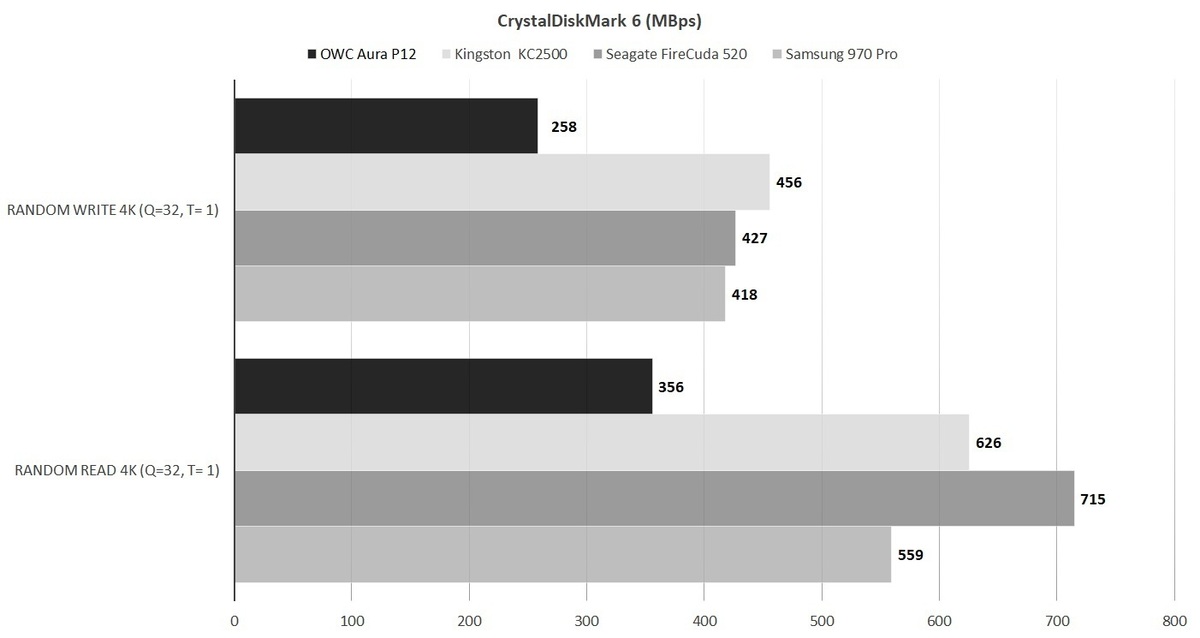The OWC Aura P12 has an answer for the lack of capacity in NVMe drives: 4TB. Yes, four terabytes of TLC NAND. Not only does it double the typical maximum capacity of today’s SSDs, it offers excellent everyday performance. However, as you might guess, it’s going to set you back a bit of coin.
This review is part of our ongoing roundup of the best SSDs. Go there for information on competing products and how we tested them.
Specs, price, and warranty
The Aura P19 is your standard 2280 (22 mm wide, 80 mm long) form factor, but with TLC NAND on both sides it may not fit some super-thin laptops or devices. The drive is available in five capacities starting at 240GB ($59 from OWC), 480GB ($90 from OWC), 1TB ($159 from OWC), 2TB ($349 from OWC), and 4TB ($929 from OWC), respectively. The rest of the industry is catching up fast: After our initial write-up, Sabrent released a 4TB NVMe QLC SSD and an 8TB QLC SSD.
OWC makes hay out of the seven-percent overprovisioning, which is generally what you get when you ship in off capacities—240GB rather than 250GB, 480GB rather than 500GB flavors, and so on. It also mentions SLC caching, which is something all TLC NAND NVMe SSDs offer. This means that part of the TLC (stacked 96-layer on the P12) is treated as SLC by writing only one bit. It’s the overhead in writing 3 or 4 bits that makes TLC and QLC slow. The controller on the P12 is a PS5012-E12S by Phison, the company behind many SSDs from second-tier vendors.
OWC’s Aura P12 is the first 4TB M.2 NVMe SSD we’ve reviewed. The extra capacity costs, but will be manna for those with the need.
The Aura P12 is warrantied for five years; however, there is no TBW (TeraBytes Written) rating. Given the overprovisioning, I’d guess you shouldn’t worry that the drive will wear out in 10 years of normal use, let alone 5.
Performance
For the most part, the Aura P12 performed very well. You’d likely never notice any dropoff from the other drives it’s compared to, unless you copy very large amounts of data. However, we did get some unexpected scores with queued 4K files.
 IDG
IDGCrystalDiskMark 6 rated the Aura P12’s sequential transfers as very good. This is the 1GB tests. Longer bars are better.
As you can see above, the Aura P12 aced the sequential reading and writing tests. Moving on to the next test (below), however, it didn’t do particularly well (for an NVMe drive) with the 4K transfers. Fewer-queue and no-queue 4K transfers lagged by the same amount.
Normally, the results of the 4K tests vary so little that I don’t even include them, but the Aura P12’s were significantly slower than the norm.
 IDG
IDGFor some reason, likely to do with cache, the Aura P12 wasn’t quite ace reading or writing 4K files. Longer bars are better.
In the real world, the Aura P12 tied the Kingston KC2500 when performing 48GB transfers. It didn’t fare as well with the 450GB transfer we also run (not shown), averaging just over 1GBps compared to the KC2500’s 1.25GBps, and the FireCuda’s 1.7GBps.

Introvert. Beer guru. Communicator. Travel fanatic. Web advocate. Certified alcohol geek. Tv buff. Subtly charming internet aficionado.
